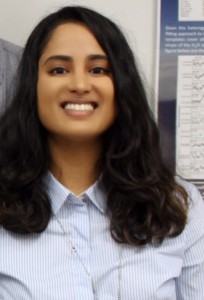CSUN Graduate Student Leads Study at NASA’s Jet Propulsion Laboratory

Photo courtesy of Aishwarya Iyler.
It’s Wednesday night, and Aishwarya Iyer is excited to begin her night shift at NASA’s Jet Propulsion Laboratory (JPL) in Pasadena. She has spent a week sitting in front of her computer in a small cubicle, where she has evaluated and analyzed data for several hours a day. She submits the coordinates of this night’s target planet to the 13,802-foot-high summit telescope in Mauna Kea, Hawaii, and selects the instrument of choice offered by the telescope facility to study the atmosphere of this planet.
Iyer, a graduate student in California State University, Northridge’s physics program, started working for JPL in summer 2014 as an undergraduate at the University of California, San Diego (UCSD). Over the past year, she had the opportunity to lead an entire study on exoplanets — planets outside Earth’s solar system. She’s passionate about the research she has been conducting at JPL, and one of her favorite parts of the job is the occasional late-night observation run that provides an opportunity to observe planets physically, she said.
“Those are the most fun days of the semester,” Iyer said. “When we’re done with all the legwork, and you can actually get to the science aspect of it.”
Most of Iyer’s work involves days of programming and evaluating huge data sets to obtain quality results from reducing data acquired during the observation runs. Her current work focuses on characterizing the atmospheric properties of 19 “hot Jupiters” previously observed by NASA’s Hubble Space Telescope. Hot Jupiters are 1,500-degree-Fahrenheit exoplanets that have masses similar to that of Jupiter but are much closer to their parent star than our Jupiter to the sun. Iyer’s task was to classify these 19 planets to find common atmospheric features, unique to the class of hot Jupiters.
Iyer explained that a majority of these planets exhibit the presence of water vapor within their atmospheres. Previous studies however have resulted in a variety of analysis and interpretation methods. Iyer’s work was motivated by the need for standardizing this data to look for patterns. The results of the study show that water is ubiquitous in the atmospheres of hot Jupiters and that about half of the atmosphere of any hot Jupiter is blocked by clouds, haze or aerosols, thus preventing scientists from detecting the true water content.
“There’s still so much we don’t know and to know even just a little bit more than yesterday about the universe, is really one of the encouraging reasons to do research.” Iyer said.
Her study was published in the June 1 issue of The Astrophysical Journal in the June 1 issue. The results of the study could have implications on future studies of hot Jupiter atmospheres as well as for using the next generation of space observatories such as NASA’s James Webb Space Telescope.
Iyer graduated from UCSD in 2015 and moved to CSUN to pursue her master’s in physics.
“The generic norm is that people do their undergraduate [in physics] and directly go to the Ph.D. programs,” Iyer explained. “But I thought, it’s best to go through a master’s program to solidify your understanding of the core concepts, which will allow you to become a stronger candidate for a Ph.D program — that’s why I was really inclined toward taking this path.”
Iyer said she particularly values working with professors Wladimir Lyra and Farisa Morales, both faculty in CSUN’s Department of Physics. Lyra and Morales have become key mentors, she said.
“CSUN has such a wonderful physics program, which has been an important part of my whole journey,” she added. “I wouldn’t have had the courage to jump on a Ph.D. program right away, and this program is something I definitely needed.”
Iler also advocates to encourage more female students and under-represented minority students to not shy away from physics or astronomy classes.
“It is our duty as members of the academic community to build one another and provide support whenever necessary,” she said. “We must keep reminding ourselves that it is okay to struggle while solving some physics problems but when it comes to the big picture, we must realize that getting an opportunity to study any part of our magnificent universe is truly a privilege.”
Currently, Iyer is applying to various Ph.D. programs for next year and said she is very excited to get started.
“I believe that it’s very important to do what you love, and I can’t wait to work on more exciting science,” she said.

 experience
experience